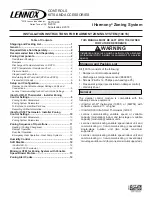
Page 18
Installation, Operation & Maintenance Manual ( IOPCKKS60220510C1)
OPERATION
SOUND POWER RATINGS
A sound power level is a measure of the total noise radiated by the machine in all directions. It is a property of the machine and is
essentially independent of the measuring environment. Sound power levels are useful to equipment manufacturers, buyers, installers,
and users for :
t
Calculating the sound pressure level from a machine at a given distance in a given environment.
t
Comparing the noise output from different machines.
t
Setting specifications for the maximum permitted noise from a machine.
t
Comparing machines before and after modifications to reduce the noise.
Sound power is measured in watts or picowatts, and sound power levels are traditionally given in decibels (dB re 1pW). Refer table 8 for
sound power level of whole unit and table 9 for sound power levels of fan only.
ESP
IWG RPM
KW
BHP
63
125
250
500
1000
2000
4000
8000
DMS-360
12000
1
705
3.6
4.83
71.26
74.26
81.26
83.26
84.26
81.26
75.26
72.26
89.26
DMS-420
13500
1
741
4.56
6.11
72.76
75.76
82.76
84.76
85.76
82.76
76.76
73.76
90.76
DMS-480
15000
1
772
5.65
7.57
75.24
78.24
85.24
87.24
88.24
85.24
79.24
76.24
93.24
DMS-600
18000
1
817
8.01
10.74
77.80
80.80
87.80
89.80
90.80
87.80
81.80
78.80
95.80
Model No.
CFM
Blower
Octave Band Frequency Hz
dB(A)
RPM
BHP
63
125
250
500
1K
2K
4K
8K
DMS-360
12000
1
705
4.8
78.5
81.1
82
81.3
79.3
79.3
76.8
69.7
85.5
DMS-420
13500
1
741
6.1
79.7
82.9
84
83.6
81.6
81.4
79.5
72.7
87.8
DMS-480
15000
1
772
7.6
80.4
84.3
85.4
85.6
83.7
83.3
81.7
75.3
89.8
DMS-600
18000
1
817
10.7
82.2
86.6
87.8
89.5
87.7
87.1
86
80.4
93.8
Total (dBA)
Model CFM
ESP
Octave Band Mid Frequency (HZ)
Blower
Ref 1 x 10^-12 watts
Table 8 : Sound Power Levels (DMS Saber Units)
Table 9 : Sound Power Levels (Standard Fans)
VOLT FREE CONTACT
All Saber units are supplied with Volt free contact, Refer to
Electrical wiring schematic that are pasted inside the unit.
CAUTION
HOOK UP EMERGENCY SHUT - OFF BUTTON
SEQUENCE OF OPERATIONS OVERVIEW
For these units, the thermostat makes a circuit between “R” and
“Y1” for the first stage of cooling. The call is passed to the unit
control board (UCB), which then determines whether the requested
operation is available and, if so, which components to energize.
For electric heat units, the UCB passes the call to the electric
heater. In both cases, when the “W1” call is sensed, the indoor air
blower is energized following a specified heating delay. If at any
time a call for both heating and cooling are present, the heating
operation will be performed. If operating, the cooling system is
halted as with a completion of a call for cooling. Heating always
takes priority.
COOLING SEQUENCE OF OPERATION
t$0/5*/6064#-08&3
By setting the room thermostat fan switch to “ON” the supply air
blower will operate continuously.
t*/5&3.*55&/5#-08&3
With the room thermostat fan switch set to “AUTO” and the system
switch set to either the “AUTO” or “HEAT” settings, the blower is
energized whenever a cooling or heating operation is requested.
The blower is energized after any specified delay associated with
the operation. When energized, the indoor blower has a minimum
run time of 30 seconds. Additionally, the indoor blower has a delay
of 10 seconds between operations.
t/0065%003"*3015*0/4
When the thermostat calls for the first stage of cooling, the low
voltage control circuit from R to YI & G is completed. For first
stage of cooling, compressor 1, condenser fan motor 1 & 2 are
energized (In case of 40 & 50 TR, condenser fan motor 1, 2 & 3 will
energize). After completing the specified fan on delay for cooling,
the UCB will energize the blower Motor.











































